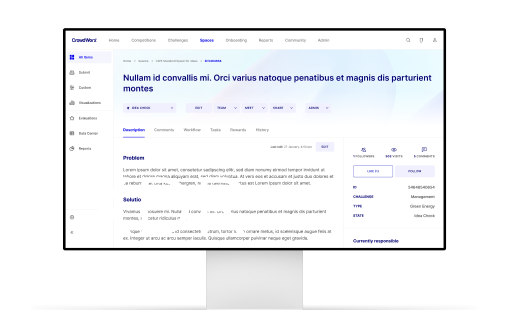Leaders understand that fostering innovation benefits both company performance and employee satisfaction, but many struggle to create environments where ideas thrive. More than one-third of organizations face challenges in developing and embedding an improvement culture. This disconnect exists despite evidence showing that engagement metrics like employee participation percentage and number of submitted ideas can be implemented with significant impact.
This guide shows you how to build and nurture a thriving a culture of innovation that drives sustainable growth and competitive advantage. You’ll discover practical strategies that reshape how your organization approaches innovation at every level, from creating the right environment to measuring real impact.
What is a culture of innovation?
A culture of innovation represents the work environment that leaders cultivate to nurture unorthodox thinking and its application. This goes beyond simply generating new ideas – it creates consistent value through fresh approaches and solutions across the organization.
Innovation cultures operate on a simple belief: groundbreaking thinking can emerge from anyone within the organization, not just top leadership. These environments are characterized by specific behavioral patterns and social norms that allow creativity to flourish at every level.
Innovative organizations share several defining traits:
• Psychological safety and openness: Employees feel secure sharing ideas without fear of ridicule or punishment. Tolerance for failure is recognized as essential for growth.
• Collaboration across boundaries: Innovation extends beyond company walls to include interactions with customers, suppliers, and business partners globally.
• Diverse perspectives: Organizations celebrate diversity of thought, experiences, and backgrounds, understanding these differences spark creativity and robust solutions.
• Experimentation mindset: Teams are encouraged to take calculated risks, learn from failures, and continuously adapt.
The most successful innovation cultures balance seemingly contradictory elements. They encourage risk-taking but maintain accountability. They value individual creativity but emphasize collaboration. They focus on current operations but keep an eye on future trends.
Companies that foster innovation understand it’s not a random process but something that requires intentional design – an operating structure encouraging trust, inclusiveness, ownership, and alignment. Those that succeed recognize innovation isn’t just beneficial but necessary for survival in rapidly changing markets.
Why innovation culture matters more than ever in 2025
Innovation isn’t just a competitive advantage anymore – it’s survival. Companies with strong innovation cultures stand distinctly apart from their competitors.
McKinsey reports that 84% of executives believe innovation is crucial to their growth strategy, yet only 6% are satisfied with their innovation performance. This alarming gap illustrates why building a culture of innovation has become non-negotiable for forward-thinking organizations.
Companies with established innovation cultures are 60% more likely to be innovation leaders in their industries. These organizations typically employ 10% fewer full-time innovation staff, proving that when creativity becomes everyone’s responsibility, specialized roles become less necessary.
Why does innovation culture matter now?
- It directly impacts financial performance and adaptability
- It addresses the growing employee engagement crisis
- It ensures sustainable competitive advantage in rapidly changing markets
The message is clear: without a sincere, honest, and daring culture that puts people at the center, there will be no results in the medium term. When changes in our surroundings occur faster than within the organization itself, the end is near. Culture isn’t just eating strategy for breakfast – it has become the strategy itself.
Create the Right Environment for Innovation
The environment where innovation happens matters as much as the innovation itself. Building a culture of innovation requires deliberate construction of spaces – both physical and psychological – where new ideas can flourish.
Psychological safety and open feedback
What makes employees feel safe to share their wildest ideas? Psychological safety – defined as “a belief that one will not be punished or humiliated for speaking up with ideas, questions, concerns, or mistakes” – forms the cornerstone of innovative environments.
Feedback-driven cultures significantly enhance both creativity and morale. Employees readily share ideas when they know their input receives constructive, regular feedback. Leaders who actively integrate feedback show a 60% increase in their ability to change and a 45% improvement in team relationships.
How to build psychological safety:
✅ Schedule regular forums for sharing ideas and concerns without judgment.
❌ Misstep to avoid: Dismissing ideas quickly or publicly criticizing contributions.
✅ Provide anonymous feedback tools that help introverted team members contribute.
❌ Misstep to avoid: Making idea-sharing only available through public channels.
✅ Model vulnerability by admitting mistakes and encouraging calculated risk-taking.
❌ Misstep to avoid: Leaders who never acknowledge their own failures or uncertainties.
Breaking down silos and hierarchy
Organizational silos kill innovation by creating echo chambers that recycle the same experiences and ideas. They reduce productivity, efficiency, and agility by slowing project progress and decision-making.
Cross-functional teams offer a powerful solution. These teams benefit from multiple perspectives, broader skill sets, and fresh ideas.
Flat organizational structures accelerate communication by removing bureaucratic barriers. Without hierarchical red tape, organizations respond more swiftly to market changes and emerging trends.
Encouraging diverse perspectives
Diverse teams bring unique insights that challenge conventional thinking and excel at tackling complex challenges, identifying opportunities that uniform teams typically miss.
The combination of psychological safety and diversity creates powerful results. Teams with high psychological safety see diversity positively correlate with performance. This environment allows team members to contribute their authentic perspectives without fear.
The evidence is clear: diverse groups consistently generate more innovative solutions than homogeneous groups. Foster an inclusive culture that values various viewpoints to unlock creativity that drives competitive advantage in increasingly complex markets.
Build Consistency Through Systems and Rituals
Innovation cultures don’t happen by accident – they require consistent systems and rituals that reinforce creative behaviors throughout your organization. Once you’ve established the right environment, you must embed innovation into your company’s DNA through deliberate practices.
Embedding innovation in daily work
To transform innovation from an occasional event into continuous practice, organizations need structured opportunities that stimulate creativity. Regularly scheduled activities like hackathons, innovation challenges, or brainstorming sessions effectively generate ideas and solutions.
Using tools and frameworks effectively
An innovation framework serves as a blueprint for how companies approach innovation, from idea generation to successful implementation. These frameworks help businesses move from abstract concepts to tangible outcomes, making it easier to coordinate activities and allocate resources.
Digital platforms like Crowdworx enable employees to submit, discuss, and develop ideas, enhancing communication across the organization. Innovation management software simplifies complex processes by tracking progress, facilitating collaboration, and ensuring strategic alignment. These tools offer robust analytics that allow organizations to monitor performance and make informed decisions about resource allocation.
Tracking progress and celebrating wins
Without clear metrics, you can’t measure the success of innovation efforts. Develop key performance indicators aligned with your goals and regularly review them to optimize outcomes. Consider tracking both input metrics (resources invested) and output metrics (results achieved).
Celebrating success significantly impacts workplace productivity by creating positive environments where employees view their company as a place to grow. Organizations that recognize achievements see numerous benefits:
- Increased workplace productivity
- Enhanced team collaboration
- Improved efficiency
- Greater retention
Ensure your recognition practices remain equitable to avoid favoritism or unconscious bias undermining your efforts. A comprehensive recognition program helps celebrate moments both big and small, ensuring every team member feels valued for their contributions.
How to assess your current innovation culture
You need to understand where you stand before you can chart a path forward. Assessing your current innovation culture resembles using a GPS – you must pinpoint your exact starting position before mapping your destination.
Use surveys and feedback tools strategically
Start with the right assessment tools tailored to your specific goals. Organizations can employ several effective instruments:
- Comprehensive surveys: Ask if management genuinely seeks and responds to ideas.
- Innovation readiness assessments: Focus on three critical areas – leadership support, organization design, and innovation practice. They measure how successfully your company innovates consistently rather than running one-off projects.
- Stakeholder interviews: Involve everyone from executives to frontline employees. This provides invaluable insights and offers a complete view of your innovation culture.
Here’s why objective assessment matters: 78% of senior leaders believe they already have a culture of creativity and innovation, yet only 28% of employees agree. This gap highlights the disconnect between leadership perception and reality.
Identify what blocks and enables innovation
Pinpointing what hinders innovation remains just as important as recognizing what supports it.
Look for key attributes like tolerance for failure, cognitive diversity, continuous improvement practices, and psychological safety.
Use structured exercises to identify specific behavioral patterns. Gather employee groups and have them complete two sentences: “Wouldn’t it be great if we…” and “But we don’t because…”. This quickly surfaces desired behaviors and their obstacles.
One of the most damaging barriers is unconscious bias against creativity. Despite openly requesting outside-the-box thinking, many leaders subconsciously reject novel ideas, especially when motivated to reduce uncertainty.
Measuring your innovation culture isn’t just about collecting data – it’s establishing the foundation for meaningful change.
Measuring and Sustaining Innovation Culture
Measuring what works is essential for sustaining innovation culture. Traditional business processes have standardized milestones, but innovation requires different measurement approaches that capture both tangible outcomes and cultural shifts.
Key metrics to track progress
Smart organizations use a balanced approach to innovation metrics, combining quantitative and qualitative indicators. Companies track metrics such as patents filed, new products introduced, and percentage of revenue from recent innovations. Numbers tell only part of the story – qualitative indicators like employee comfort with challenging assumptions or frequency of experimentation discussions provide vital context.
Create a measurement framework using three categories:
- Business metrics – Focus on outcomes by evaluating success factors and conditions under which objectives are achieved
- Culture metrics – Assess people-related competencies and cultural consequences, emphasizing continuous learning
- Leadership metrics – Measure decisions and strategies leaders use to achieve innovation objectives
The most effective approach combines input metrics (innovation enablers you invest in) with output metrics (results of those investments). Instead of merely tracking R&D spending, measure this investment against revenue generated from recently launched products.
Organizations often struggle with measurement since long-term benefits of innovation cultures remain ambiguous and intangible. Track specific indicators like employee participation percentage, time-to-market, customer adoption rates, and ROI on innovation projects to demonstrate tangible progress.
Sustaining innovation requires treating it as an ongoing practice rather than a one-time initiative. Successful innovators regularly celebrate wins, reinforce desired behaviors through recognition, and create positive momentum that builds upon itself. Measure both cultural attributes and innovation components to develop the view needed to nurture innovation maturity over time.
Key Takeaways
Building a culture of innovation in 2025 requires deliberate leadership actions and systematic approaches that empower every employee to contribute creatively.
• Psychological safety is non-negotiable: Create environments where employees feel secure sharing ideas without fear of punishment—teams with high psychological safety are 60% more likely to transform diverse perspectives into innovative solutions.
• Break down silos and hierarchies: Cross-functional teams and flat structures accelerate innovation, with 83% of digitally mature organizations using cross-functional approaches compared to only 55% of early-stage companies.
• Embed innovation into daily operations: Use structured systems and regular innovation sprints to make creativity a consistent practice rather than occasional events.
• Empower everyone, not just leaders: Organizations that distribute decision-making authority see 30% efficiency increases, proving innovation thrives when ownership extends beyond executive circles.
• Measure both culture and outcomes: Track quantitative metrics (patents, revenue from new products) alongside qualitative indicators (employee comfort with risk-taking) to sustain long-term innovation success.

